
Methane and Super Pollutants: A New Pillar to Support Carbon Markets
Controlling super pollutant emissions can have a rapid, outsized impact on climate change, while offering high quality carbon credits. Markets are taking notice.
Hello once more, and thank you for reading!
Good things often come in fours – the ancient Greeks believed in four elements of earth, air, fire, and water; The Three Musketeers had Athos, Porthos, Aramis, and D’Artagnan; and the Beatles were a (Fab) Four.
The same can be true for carbon markets. To date voluntary and compliance sectors have stood on three major pillars of credit classes: avoidance (including RECs and REDD+), nature based solutions, and durable carbon dioxide removal.
Today I’m going to provide an overview on what I believe to be the fourth ‘pillar’ of carbon markets: methane and super pollutant elimination credits. Controlling emissions of these non-CO2 gases are crucially important for shaving off near-term temperature increases as they have an outsized impact on global warming relative to CO2. While I’m going to synthesize from a wide variety of sources, most of my focus will be on methane as the super pollutant most responsible for warming to date.
This is not to say that we don’t need crediting for CO2 – rather that a portfolio approach that includes the all important “e” in CO2e for ‘equivalent’, which can change the shape of carbon markets and provide an important tool for supporting climate action.
Here’s three questions I’m going to address briefly:
-
- Why are Super Pollutants so important?
- How are solutions for them created today?
- What makes this new category ‘real’ in carbon markets?
Why are Methane and Super Pollutants so important?
Methane, nitrous oxide, and ozone depleting fluorocarbons account for a significant portion of climate change forcing that we are experiencing today. Methane emissions are responsible for about 30% of recent warming , and nitrous oxide has caused about 10% of warming.
Even though super pollutant concentrations are much lower than CO2 in the atmosphere (e.g. methane is at around ~2ppm vs CO2’s 420ppm), super pollutant gases have a high global warming potential as measured over a 100 year time period relative to CO2:
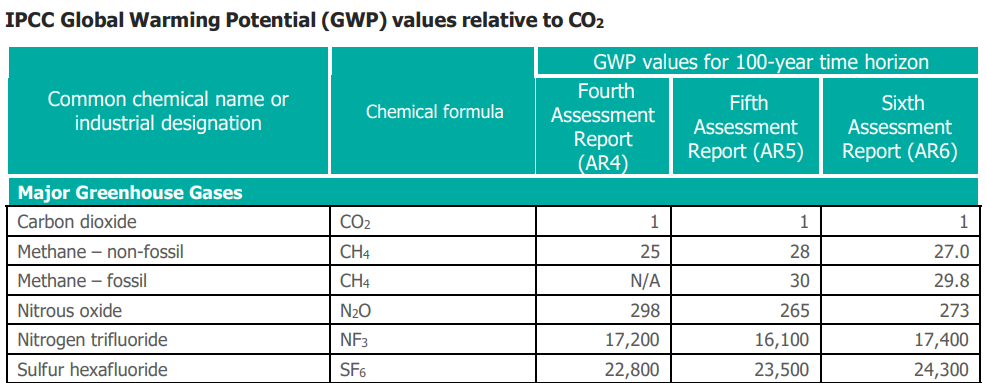
Eliminating these emissions are a huge opportunity for impactful climate action to manage as outlined in the US National Academy of Science Engineering and Math report in 2024. Targeting non-CO2 greenhouse gases can shave off significant risks from climate change before 2050:
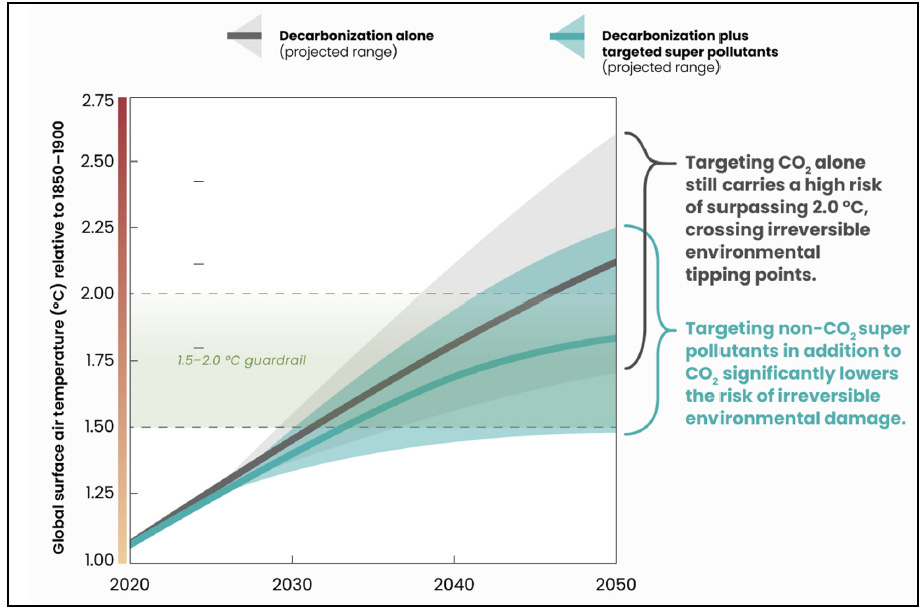
The speed of change by managing methane emissions is striking. Because the CH4 molecule is active and unstable, it breaks down within 15 years – so stopping emissions now could lead to a rapid decline in atmospheric concentrations. To use the famous ‘bathtub’ metaphor, it’s not just that stopping water entering the tub means that the water doesn’t rise anymore: it means that the excess water (i.e. ambient atmospheric methane) will disappear in a fraction of the time relative to CO2.
The result, per Dr. Gabriel Dreyfus et al:
“non-CO2 targeted measures when combined with decarbonization can provide net cooling by 2030 and reduce the rate of warming from 2030 to 2050 by about 50%, roughly half of which comes from methane”
In other words, we can slow down global warming by focusing activity on methane and other non-CO2 super pollutants.

How do we create solutions for Super Pollutants?
To start, the atmospheric science community is advancing rapidly to pinpoint hotspots now visible through satellite imagery or other detection solutions. Turning off these excess emission sources at the metaphorical spigot enables businesses to generate emissions avoidance credits. Destroying these gases as well is a credit generating project.
Considering methane, major emission sources include but are not exclusively:
-
- Oil and Gas extraction, transport, and distribution
- Livestock enteric methane emissions
- Landfill emissions
- Wastewater processing emissions
- Agricultural emissions, particularly rice farming
- Permafrost emissions
- Wetland emissions
Businesses are springing up to develop solutions for reducing Super Pollutant emissions, building revenue streams on emissions mitigation or destruction credits. Crediting mechanisms for these activities are coming online as well, especially as new projects deploy to manage the different classes of super pollutants.
Note: Methane credits today are emission avoidance credits. While the prospect of ambient methane removal is quite exciting, the technology may be many years away from field deployment and commercialization at the time of this writing.
In the voluntary carbon market, several crediting methodologies are in place already, and their registries have been issuing credits. Projects for landfill methane emissions have been in existence for several years, using Climate Action Reserve and Verra for methane management crediting based on activities with landfills, livestock, and coal mines.
Other registries and registry endorsing bodies are taking notice as well, with American Carbon Registry and the International Carbon Registry (ICR) creating methodologies for capping orphaned, abandoned, or marginally producing oil and gas wells – noting that ICROA granted unconditional endorsement to ICR in January 2025. Furthermore, in June 2024, the Integrity Council for Voluntary Carbon Markets approved using the Core Carbon Principle label on 27 million issued methane and ozone-depleting substance destruction credits. These quality labels are crucial for establishing trust in the credits and projects that they issue from.
For nitrous oxide, 40% of emissions are from human activities, primarily from agriculture, per the IPCC, so efforts at stopping emissions in that economic sector would be a path forward – enough to warrant a methodology for crediting nitrous oxide photocatalysis.
Ozone Depleting Substances (ODS) such as CFCs and HCFCs typically come from leaking older refrigerant systems. Collecting and destroying these containers to create carbon credits is painstaking project work, but which offers financial incentives to build a business.
Beyond voluntary markets, compliance markets have protocols as well for projects that collect and destroy Ozone Depleting Substances, with projects generating credits that have been traded systems in California and Washington State. Based on voluntary market price points for non-CO2 credits (more on this shortly), these credits trade at or below Washington and California compliance market clearing prices¹, as well as below UK and EU ETS prices at the time of this writing.²
What makes the Super Pollutant opportunity real for carbon markets?
Several factors are key drivers, including price, co-benefits profile, and third-party rated quality measures.
Price points. These projects are coming into the market at a price that is within the range conducive to adoption in voluntary and compliance markets. The table below that summarizes the four major pillars, with price points, supplied by Robert Cheesewright and Tom Fallows at Pinwheel:
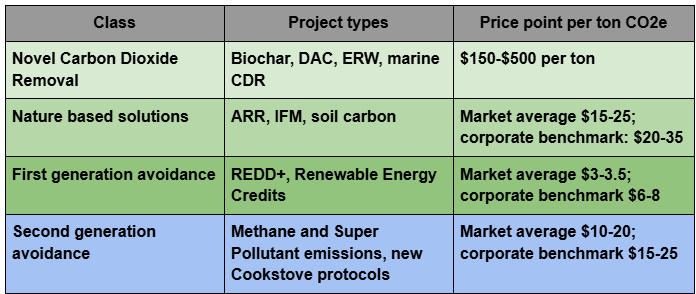
The price point of the ‘second generation avoidance’ credits stands out, sitting between first generation avoidance and higher priced durable carbon removal, and roughly at the same level as Nature-based solutions. Considering strictly price and quantity of credits, this price point would suggest that methane and super pollutant projects would be able to command the same transaction volume as large quantity nature based projects. In fact, there are some hints at this already with Guacolda Energia retiring 2.3 million methane credits in February 2025.
Co-Benefits. The co-benefits narrative behind methane and super pollutant credits are more challenging to tell in comparison to more compelling stories surrounding other types of credit projects. Put bluntly, nature-based, carbon removal, REDD+ or REC credit projects have found an easier time to weave their story into ESG reporting and speak to the community story behind projects. Qualitatively, as noted by Calyx Global ratings, methane and Super Pollutant credits are not as ‘charismatic’ as many other classes of credits, and as such may be undervalued by carbon markets.
Credit Quality. Building on the co-benefits stories, Calyx notes that these ‘uncharismatic’ super pollutant projects tend to have a higher credit rating than their more ‘charismatic’ counterparts:
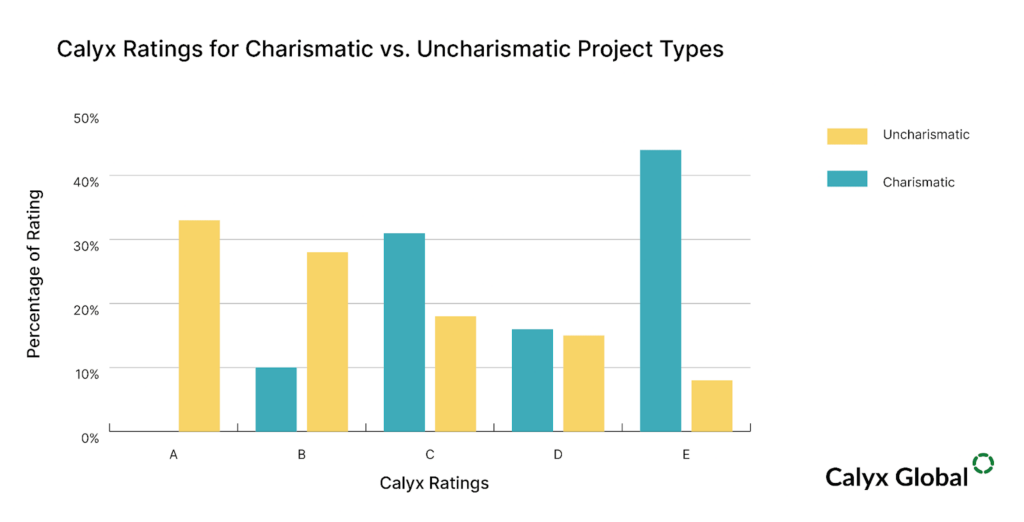
This is not to say that ‘charismatic’ projects are bad – far from it – or that their quality ratings won’t improve – they likely will over time with more rigorous methodologies and enhanced project management practices and technologies. That said, in the current carbon market environment which is seeing a preference to quality measures, credit purchasers are demanding more Super Pollutant credits.
Market results. In light of the trends above, the methane and super pollutant credit purchases and retirements are expanding rapidly. To wit, 2024 methane credit retirement volume increased 70% over 2023. Reaching nearly 4.4 million credits in that calendar year³, methane alone representing about 2.5% of the 175 million voluntary carbon market retirements in 2024.4
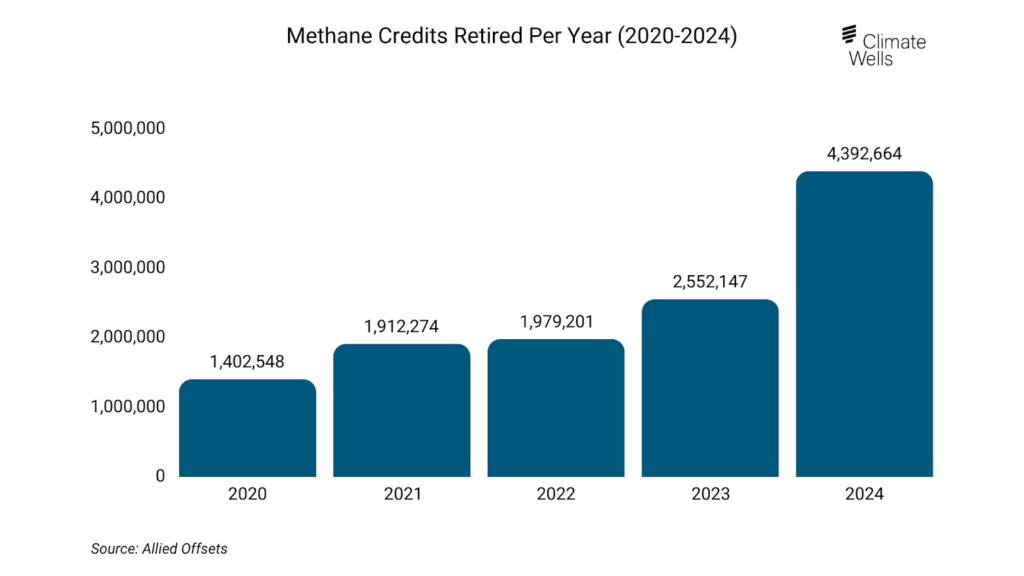
This trend is continuing in 2025 as well, with Q1 non-CO2 retirements seeing the largest number of non-CO2 gas credit retirements on record per MSCI.5

The market conditions for this growth are making for a methane and super pollutant moment. The growth of retirements in voluntary markets suggests that corporates prefer highly rated quality credits at a price point approximately akin to nature-based ARR, IFM, or soil carbon credits. The advent of new technologies, new projects, new crediting methodologies and (most importantly) the endorsement of registries themselves by quality monitoring bodies is a key driver of this trend. These are reasonably priced, high quality credits, though project co-benefits outside of emissions reduction is a hindrance.
Conclusion
Methane and Super Pollutant Elimination credits are an unheralded and rapidly growing segment of the market. These projects offer clear and direct climate benefit in the near term, and are settling in at prices and volumes that suit the needs of voluntary and compliance markets. As such, they slot in nicely to a portfolio as a fourth ‘pillar’ alongside traditional avoidance offsets, nature based credits, and durable carbon removal.
My take:
-
- Super pollutant emissions represent a clear and actionable, though overlooked, focus area in climate.
- Action to reduce methane emissions in particular can lead to significant climate impact in short order.
- Several solution pathways are in place already with more under development.
- Carbon credit markets are expanding rapidly for these emission reducing or destroying activities.
What do you think?
Jason Grillo is the Principal of Earthlight Enterprises marketing consultancy, Co-Founded AirMiners, and is a voluntary contributor to CDR.FYI. The opinions expressed in this writing are the author’s own and do not reflect the position of any employer or associated organization.
1Washington State March 2025 auction settled at $50 per allowance, California + Quebec combined markets auction in February 2025 settled at $29.27 USD.
265 EUR/ton for the EU ETS, $47 USD/ton for UK ETS. Source: https://carboncredits.com/carbon-prices-today/ accessed April 19, 2025
3Thanks to ClimateWells for posting this data on their blog and their CEO Reid Calhoon for placing Q1 charts on LinkedIn.
4Sylvera, The State of Carbon Credits 2024
5Posted on LinkedIn by ClimateWells CEO, Reid Calhoon, here


























